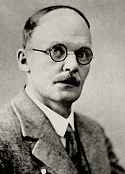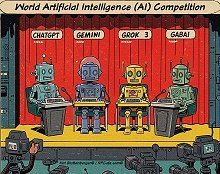Electronics Pioneers & History
- See Full List of AI Topics -
 Hans Wilhelm Geiger, born on September 30, 1882,
in Neustadt an der Weinstraße, Germany, is best known for inventing the Geiger counter,
a pivotal device in the field of nuclear physics for detecting ionizing radiation.
He grew up in an intellectually stimulating environment, as his father, Wilhelm
Ludwig Geiger, was a prominent philologist and professor at the University of Erlangen,
where he specialized in Indo-European languages. His mother, Hedwig Geiger (née
Höhler), also came from a well-educated family, and together his parents fostered
a household where academic inquiry was highly valued. Hans Wilhelm Geiger, born on September 30, 1882,
in Neustadt an der Weinstraße, Germany, is best known for inventing the Geiger counter,
a pivotal device in the field of nuclear physics for detecting ionizing radiation.
He grew up in an intellectually stimulating environment, as his father, Wilhelm
Ludwig Geiger, was a prominent philologist and professor at the University of Erlangen,
where he specialized in Indo-European languages. His mother, Hedwig Geiger (née
Höhler), also came from a well-educated family, and together his parents fostered
a household where academic inquiry was highly valued.
Geiger's childhood was marked by a strong sense of discipline and a keen interest
in scientific exploration. He attended secondary school in Erlangen, where his father
had taken a professorship, and developed an early passion for mathematics and physics.
This passion guided his decision to pursue higher education in these subjects. In
1902, Geiger enrolled at the University of Erlangen, where he studied under the
guidance of leading physicists and mathematicians of the time. He later transferred
to the University of Munich, where he completed his doctoral studies in 1906. His
doctoral thesis focused on electrical discharges through gases, a subject that would
lay the groundwork for his future research in atomic physics and radiation detection.
Upon completing his education, Geiger moved to England, where he took up a research
position at the University of Manchester. There, he had the opportunity to work
alongside the renowned physicist Ernest Rutherford, a collaboration that would prove
to be instrumental in Geiger's career. In Rutherford's laboratory, Geiger contributed
to key experiments in radioactivity, particularly those involving the scattering
of alpha particles. In 1908, Geiger and Rutherford developed an early version of
the Geiger counter, which could detect alpha particles by measuring their ionization
of gases. This invention became a fundamental tool in atomic physics and was later
refined by Geiger into the more widely known Geiger-Müller counter, developed in
collaboration with his student Walther Müller in the 1920s. The Geiger-Müller counter
could detect not only alpha particles but also beta particles and gamma rays, making
it a versatile device in the study of ionizing radiation.
Geiger's professional trajectory was closely tied to his work with Rutherford.
In 1911, Geiger played a critical role in the famous gold foil experiment, which
provided empirical evidence for Rutherford's nuclear model of the atom. In this
experiment, Geiger and his fellow researcher, Ernest Marsden, observed the deflection
of alpha particles after passing through a thin sheet of gold foil. The results
of this experiment led to the revolutionary conclusion that atoms consist of a dense,
positively charged nucleus surrounded by orbiting electrons, a discovery that reshaped
our understanding of atomic structure.
After returning to Germany in 1912, Geiger began to build his own reputation
as a leading physicist. He took up a professorship at the University of Kiel, where
he continued his research into atomic physics and radiation detection. His work
was interrupted by World War I, during which he served in the German army, applying
his expertise in ballistics and military engineering. After the war, he resumed
his academic career, holding positions at several German universities, including
those in Frankfurt and Tübingen, before finally settling at the Technische Universität
Berlin in 1929.
Throughout the 1920s and 1930s, Geiger remained at the forefront of research
into nuclear physics. His invention of the Geiger-Müller counter revolutionized
the ability of scientists to study radiation and led to further advancements in
atomic theory and quantum mechanics. Geiger's contributions to physics extended
beyond his inventions; he published numerous papers on topics related to radioactivity,
cosmic rays, and nuclear physics. His 1928 publication, "Measurement of the Ionization
of Alpha Particles," outlined methods for detecting and measuring radiation, which
became foundational in both scientific research and practical applications such
as medical imaging and nuclear safety.
Geiger was an active participant in the German scientific community, and his
work was recognized internationally. He was a member of the German Physical Society
and the Prussian Academy of Sciences. Geiger's professional friendships and associations
included collaborations with some of the most prominent physicists of his time,
such as James Chadwick, Niels Bohr, and Max Planck. His relationship with Bohr was
particularly significant, as both shared a deep interest in the study of atomic
structure and quantum mechanics. Bohr's theoretical insights into the nature of
atomic particles complemented Geiger's experimental innovations, leading to a fruitful
exchange of ideas that advanced the field of atomic physics.
In terms of political affiliations, Geiger's views remained largely apolitical
throughout much of his life. He was primarily focused on his scientific work, though
like many German scientists of his generation, he faced significant challenges during
the rise of the Nazi regime in the 1930s. While Geiger did not openly oppose the
Nazi regime, neither did he actively support it. He continued his research quietly
during the Nazi era, largely isolating himself from the political turmoil of the
time. Some of his colleagues, such as the physicist Werner Heisenberg, became more
directly involved in navigating the complex relationship between the German scientific
community and the Nazi government, but Geiger maintained a low political profile.
In terms of religion, little is known about Geiger's personal beliefs, but like
many scientists of his era, he approached the world with a rationalist perspective,
prioritizing empirical evidence and scientific inquiry over religious doctrine.
His personal writings suggest that he viewed his work as a means to understand the
natural laws governing the universe, though he did not publicly express any strong
religious convictions.
Geiger's health began to decline in the 1940s, and by the late 1940s, he suffered
from various ailments. His dedication to his work remained steadfast despite these
challenges. He continued to reside in Berlin throughout much of his later life,
though the devastation of World War II and the subsequent division of Germany had
a profound impact on his professional and personal life. He remained involved in
academic life as long as his health allowed, but his active research career slowed
considerably after the war.
Geiger passed away on September 24, 1945, just days before his 63rd birthday,
in Potsdam, Germany. His legacy as a physicist and inventor, however, remains monumental.
The Geiger counter is still widely used today in various fields, from radiation
safety and environmental monitoring to medical diagnostics and scientific research.
His pioneering work in detecting radiation also laid the groundwork for future developments
in particle physics, nuclear energy, and quantum mechanics.
Hans Geiger's life was marked by his remarkable ability to combine theoretical
insight with practical invention. His close professional relationships with some
of the most influential scientists of his time, as well as his groundbreaking contributions
to atomic theory and radiation detection, ensured his place in the annals of scientific
history. Though he lived during a time of great political upheaval, Geiger's focus
remained resolutely on advancing the understanding of atomic phenomena, a pursuit
that would have far-reaching implications for the scientific and technological advancements
of the 20th century.
 This content was generated by primarily
with the assistance of ChatGPT (OpenAI), and/or
Gemini (Google), and/or
Arya (GabAI), and/or Grok
(x.AI), and/or DeepSeek artificial intelligence
(AI) engines. Review was performed to help detect and correct any inaccuracies; however,
you are encouraged to verify the information yourself if it will be used for critical
applications. In all cases, multiple solicitations to the AI engine(s) was(were)
used to assimilate final content. Images and external hyperlinks have also been
added occasionally - especially on extensive treatises. Courts have ruled that AI-generated
content is not subject to copyright restrictions, but since I modify them, everything
here is protected by RF Cafe copyright. Many of the images are likewise generated
and modified. Your use of this data implies an agreement to hold totally harmless
Kirt Blattenberger, RF Cafe, and any and all of its assigns. Thank you. Here is
Gab AI in an iFrame. This content was generated by primarily
with the assistance of ChatGPT (OpenAI), and/or
Gemini (Google), and/or
Arya (GabAI), and/or Grok
(x.AI), and/or DeepSeek artificial intelligence
(AI) engines. Review was performed to help detect and correct any inaccuracies; however,
you are encouraged to verify the information yourself if it will be used for critical
applications. In all cases, multiple solicitations to the AI engine(s) was(were)
used to assimilate final content. Images and external hyperlinks have also been
added occasionally - especially on extensive treatises. Courts have ruled that AI-generated
content is not subject to copyright restrictions, but since I modify them, everything
here is protected by RF Cafe copyright. Many of the images are likewise generated
and modified. Your use of this data implies an agreement to hold totally harmless
Kirt Blattenberger, RF Cafe, and any and all of its assigns. Thank you. Here is
Gab AI in an iFrame.
AI Technical Trustability Update
While working on an update to my
RF Cafe Espresso Engineering Workbook project to add a couple calculators about
FM sidebands (available soon). The good news is that AI provided excellent VBA code
to generate a set of Bessel function
plots. The bad news is when I asked for a
table
showing at which modulation indices sidebands 0 (carrier) through 5 vanish,
none of the agents got it right. Some were really bad. The AI agents typically explain
their reason and method correctly, then go on to produces bad results. Even after
pointing out errors, subsequent results are still wrong. I do a lot of AI work
and see this often, even with subscribing to professional versions. I ultimately
generated the table myself. There is going to be a lot of inaccurate information
out there based on unverified AI queries, so beware.
Electronics & High Tech
Companies | Electronics &
Tech Publications | Electronics &
Tech Pioneers | Electronics &
Tech Principles |
Tech Standards Groups &
Industry Associations | Societal
Influences on Technology
|




 Hans Wilhelm Geiger, born on September 30, 1882,
in Neustadt an der Weinstraße, Germany, is best known for inventing the Geiger counter,
a pivotal device in the field of nuclear physics for detecting ionizing radiation.
He grew up in an intellectually stimulating environment, as his father, Wilhelm
Ludwig Geiger, was a prominent philologist and professor at the University of Erlangen,
where he specialized in Indo-European languages. His mother, Hedwig Geiger (née
Höhler), also came from a well-educated family, and together his parents fostered
a household where academic inquiry was highly valued.
Hans Wilhelm Geiger, born on September 30, 1882,
in Neustadt an der Weinstraße, Germany, is best known for inventing the Geiger counter,
a pivotal device in the field of nuclear physics for detecting ionizing radiation.
He grew up in an intellectually stimulating environment, as his father, Wilhelm
Ludwig Geiger, was a prominent philologist and professor at the University of Erlangen,
where he specialized in Indo-European languages. His mother, Hedwig Geiger (née
Höhler), also came from a well-educated family, and together his parents fostered
a household where academic inquiry was highly valued. 



